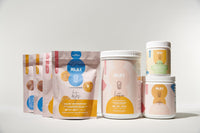Over 60% of pregnancies result in an abdominal separation that is wider than 2 – 2.5 finger-widths apart. Pregnant moms who experience this abdominal separation are considered to have the condition of “Diastasis Recti” or Diastasis Recti.
This condition typically develops in the latter part of the second or third trimester as the abdominal wall has begun to stretch to accommodate the growing baby.
Factors that lead to Diastasis Recti developing in pregnancy include gaining a lot of weight quickly upon becoming pregnant, gaining too much weight throughout the duration of your pregnancy, if you are carrying more than one baby, you have a big baby, if you are over the age of 35, if you have subsequent pregnancies that are close together or if you had poor core strength or posture pre-pregnancy.

The good news is that in most cases, Diastasis Recti in pregnancy will heal naturally post-birth, especially if you take the right steps and do the correct exercises while pregnant.
There are many things that can be done to limit diastasis recti during pregnancy.
First, I recommend that all pregnant women check themselves for Diastasis Recti in order to avoid accidentally making the Diastasis Recti condition worse.
You can use the same traditional Diastasis Recti test in pregnancy and postpartum and can look for other signs that may indication you have Diastasis Recti during pregnancy.
How to Know if You Have Diastasis Recti During Pregnancy:
|
If you do have Diastasis Recti during pregnancy, or in order to try to limit the risk of you getting Diastasis Recti, there are a number of steps you can take.

How to Limit Diastasis Recti During Pregnancy:
-
Proper Posture:
You should try to maintain a neutral spine at all times. Do not stand or walk with your belly pushed out.
-
Mindful Movement:
Think about how you get up and down from the floor or a seated position. If getting out of bed or up from the floor, roll onto your side and then push up with your hands. Never use your abdominal muscles alone to get up, particularly from the latter stages of your second trimester.
-
Avoid the Cone:
Anything that causes your belly to “cone” should be avoided. Taking a look at your belly is a good way to monitor whether the abdominal pressure is too great.
-
Strengthen the Core:
Consider exercises and programs that help you maintain a strong core without increasing your risk of Diastasis Recti or making it worse. Focus on programs that include full body movements, as exercises like a squat or a lunge can be a great core workout because you need to activate your core to balance. Other core specific exercises that may help limit Diastasis Recti include things like:
- Pillow Hugs
- TVA Squeezes
- Heel Drops.

About Kate (aka BeyondFit Mom)
Short:
Kate Horney is a Pre & Postnatal Fitness Specialist with a degree in Exercise Science. She’s a busy mom of two boys who has a passion to give women the tools needed to reach their fitness, health, energy, nutrition, and training goals. Kate has over 10 years of experience in helping busy moms shed body fat, boost fitness, and learn how to live a healthy lifestyle.
Connect with Kate on social media:
Looking for more information on motherhood? Here are some free resources and articles to help you feel prepared as a new or expecting mom!
- Preparing While Pregnant: Postpartum Nutrition Strategies
- Majka's Fourth Trimester Guide
- 5 Postpartum Fitness Tips
- The Rundown on Birth Plans: Should You Have One?
Feel free to follow us @lovemajka and share your motherhood stories with us! #lovemajka #fuelingmotherhood



















